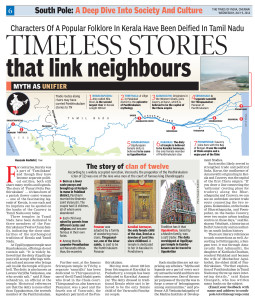 Myths and legends are a universal reality and they could be similar in contiguous lands, say anthropologists. For centuries, Kerala was a part of Tamilakam and though they have become separate political entities, both still share many myths and legends. The story of Parayi Petta Panthirukulam [12 clans born of a paraya (a low caste) woman], one of the fascinating legends of Kerala, is one such and its imprints can be spotted on the banks of Cauvery in Tamil Nadu even today.
Myths and legends are a universal reality and they could be similar in contiguous lands, say anthropologists. For centuries, Kerala was a part of Tamilakam and though they have become separate political entities, both still share many myths and legends. The story of Parayi Petta Panthirukulam [12 clans born of a paraya (a low caste) woman], one of the fascinating legends of Kerala, is one such and its imprints can be spotted on the banks of Cauvery in Tamil Nadu even today.
Three temples in Tamil Nadu have been dedicated to three members of the Panthirukulam (Twelve Clans) family, indicating the close similarities of the mythological tradition of Kerala and Tamil Nadu.
At Uppiliyappan temple, situated about six kilometers from Kumbakonam in Thanjavur district, offerings do not contain salt. “It is widely believed that the deity (Uppiliyappan) will accept only saltless offerings and anyone who brings salt inside the temple will go to hell. The deity is also known as Lavana Varjitha Venkatesa, one who avoids salt,” said R Ramachandran, an official at the temple. It is believed that this is none other than Uppukoottan, the seventh member of the Panthirukulam. Going by the legend prevalent in Kerala, Uppukoottan was a salt-seller and his descendents still live at Thrithala, the epicentre of the myth in Kerala’s Palakkad district.
Further east, at the famous Srirangam temple in Trichy, a separate ‘sannidhi’ has been dedicated to Thiurpanalvar, one of the 63 Tamil bhakti poets who lived in the Chola court. Thirupananalvar, also known as Pananar, was a poet and the fourth son of Vararuchi, the legendary patriarch of the Panthirukulam.
Moving west, about 180 km from Srirangam at Karakkal in Puducherry, a temple has been dedicated to Karakkal Matha. The deity dressed in traditional Kerala white sari is believed to be the same Karakkalamma, the only female member of the Panthirukulam.
“Similarities of these stories are not surprising and it is a fact that myths and legends are part of every society across the word,” said professor AR Venkatachalapathy of Madras Institute of Development Studies.
Robinhood stories have plenty of Indian variations. While in Kerala it is about Kayamkulam Kochunni, in Tamil Nadu it is on Mambattiyar. Panthirukulam can be one such mythology, he said.
Societies create myths and later enact them as rituals, dances, belief systems and art forms. These myths have a capacity to adapt and change over the years. It may not be able to logically or historically establish these myths. But in every society they serve some purposes. We should not take them literally but approach and understand them on the basis of what purpose they were created, he explained.
One of the major purposes of the myths was to forge a sense of belonging among communities. They are also a great source of creative imagination, Venkatachalapathy added.
Since ancient times, there is a long history of migration between Kerala and Tamil Nadu through the Western Ghats and along the Cauvery banks. Karur, the confluence of Amaravathi, a river which originates in Kerala, and Cauvery was the capital of the first Chera empire. Historians say similarities in the tradition are due to economic, political and religious ties. “If you draw a line connecting the ‘sathrams’ (resting place for traders) along the Bharathappuzha and Cauvery, we can see an unbroken ancient trade route connecting two region regions. Kolamukku, on the banks of Bharathappuzha, and Poompuhar, on the banks Cauvery, were two major urban trading centres in those days,” said Dr Keshavan Veluthatt, a historian at Delhi University and an authority on south Indian history.
Apart from trade and politics, a well-networked group of temples which thrived as part of bhakthi tradition under Alvars and Nayanars also played a great role in the cultural exchange between two regions, he said.
According to Pattinippalai, a Sangam text, it was through Amaravathi, Adimanthi (the daughter of Karikala Chozhan) reached Palakkad and became the wife of Mezhathur Agnihothri, the eldest member of the Panthirukulam. It is also believed that a large number of traders from Chola capital, Poompuhar, reached Palakkad through Cauvery for trade and commerce.
The immense popularity of the myth prompted Kerala government to fund a study to check the historicity of the legend. However, the study by the Rajiv Gandhi Centre for Biotechnology, Thiruvananathapuram, concluded that true descendants of Vararuchi’s sons may have been either extinct through time due to different genetic or social reasons or severely declined in relation to the descendants of the own men of a family lineage.
“Considering that the survival of a lineage from a single founder through 20 generations is only 9.6%, the chance of survival of Vararuchi’s lineage, which is believed to have originated 1600 years ago (45 generations), is meagre. Vararuchi episode may be a pure myth,” said Dr Sanil George of RGCB, who was a part of the study team.
“Like the historical connections between two states mythologies related to panthrikulam has also transcend the geographical boundaries. Further exploration of Panthirukulam with the Tamil Nadu may throw out interesting details, said Dr Rajan Chungath, who wrote many books on the mythology.
http://epaperbeta.timesofindia.com/Article.aspx?eid=31807&articlexml=TIMELESS-STORIES-that-link-neighbours-09072014006015
Tags: Cauvery river, Chola empire, Parayipetta panthirukulam, Poompuhar, Srirangam temple, Thrithala, twelve clan, Uppiliyappan temple, Vararuchi